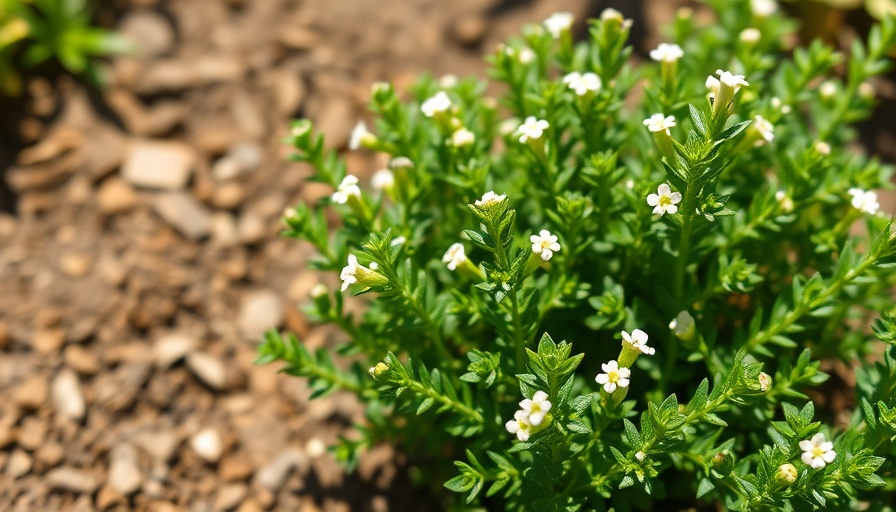
Why Thyme Matters in Your Garden
Thyme is more than just a culinary herb; it's a testament to the rich history of human connection with plants. Believed to have been cultivated for over two millennia, this resilient and fragrant herb has traveled through the ages, from ancient Egyptian tombs to modern kitchens. Whether you're a seasoned gardener or a novice, understanding thyme's characteristics and care can transform not only your garden but also your cooking.
Getting Started: The Basics of Growing Thyme
As a delicate, perennial herb, Common Thyme (Thymus vulgaris) is generally grown for both culinary and ornamental purposes. It thrives in USDA Hardiness Zones 3-11, which means it can flourish in a wide variety of climates. Planting thyme requires well-drained sandy to loamy soil with a pH of 6.5 to 8.5. The seeds can be sown on the surface or lightly covered, with a spacing of 12-24 inches to allow adequate growth and air circulation.
Thyme Varieties: Choosing the Right One for You
Among the numerous thyme species, the English (Common), French, and German varieties stand out. Each brings a slightly different flavor profile to your dishes. While English thyme has a robust flavor perfect for meats, French thyme offers a milder, sweeter taste ideal for salads and sauces. Meanwhile, German thyme retains an authentic taste and is often favored for stews and savory bakes. Selecting the right cultivar can enhance the flavors in your meals while catering to your gardening style.
Varieties and Uses: A Multifaceted Herb
Thyme is not only a culinary delight; it also boasts medicinal properties. Ancient Romans revered it as an antidote to poison, illustrating its storied significance through the ages. Beyond flavor profiles, thyme has proven benefits that may benefit your health. Rich in antioxidants, this herb supports the immune system and has anti-inflammatory qualities. Keeping it in your kitchen garden allows you to enjoy both its taste and therapeutic benefits fresh at your fingertips.
Harvesting and Preserving Thyme
Harvesting thyme is best done just before it flowers, as this is when the flavor is at its peak. Using scissors to snip stems ensures that you won't damage the plant. After harvesting, thyme can be preserved by drying or freezing. Simply bundle the stems together and hang them upside down in a cool, dry space, or chop and place them in ice cube trays covered with water and freeze them for use in your favorite dishes long after the summer season has ended.
Thyme in the Landscape: Beyond a Kitchen Herb
In addition to culinary uses, thyme works wonderfully in garden design, offering aesthetic and practical benefits. Its low-growing habit makes it an excellent choice for groundcover in landscaping, complementing other garden plants while warding off weeds. Thyme also attracts beneficial insects, like bees and butterflies, making it a valuable addition to gardens focused on pollinator success.
Connecting to Nature: Emotional Benefits of Gardening
Cultivating your thyme is about more than just harvest; it's about nurturing a living, breathing space. Gardening brings a sense of calm and connection to the environment, promoting mental well-being and reducing stress. As you tend to your thyme, you engage in a mindful practice that helps you unwind and appreciate the simple pleasures in life.
Practical Tips for Thyme Care
Thyme’s care requirements are minimal, making it an ideal choice for busy gardeners. Ensure full sun exposure with low to moderate watering needs. Regular pruning encourages bushy growth and helps the plant withstand pests like aphids and spider mites. Utilizing organic gardening techniques—like composting and natural pest control—can enhance your thyme's health while supporting the broader ecosystem.
Conclusion: Now It’s Your Turn!
With thyme thriving in your garden, your cooking will benefit from its unique flavor and the health benefits it offers. Whether you're using it in culinary preparation or exploring its place in landscape design, thyme provides joy and satisfaction. Why not start your planting journey today? You'll be surprised by how much one humble herb can enrich your life.
 Add Row
Add Row  Add
Add 




Write A Comment